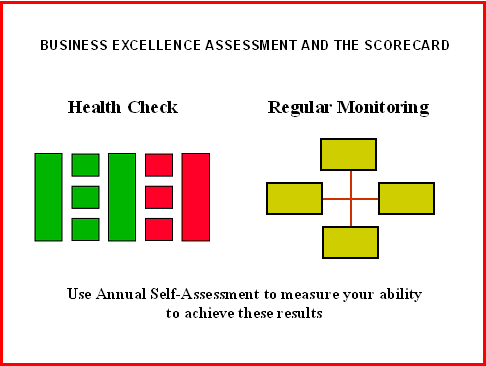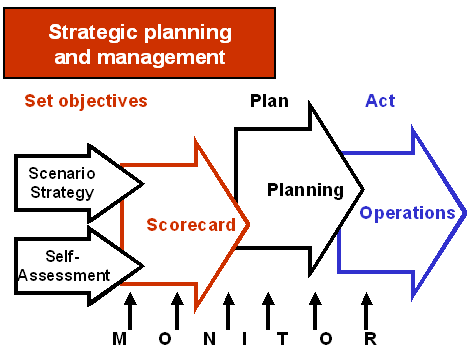Whilst the two approaches tackle the subject of
performance improvement particularly through the use
of measurement, and both rely on similar principles
of management, the Models are borne out of different
origins, take different routes and deliver different
outcomes and benefits.
The fundamental difference is that the Balanced Scorecard
is designed to communicate and assess strategic
performance, whereas the Excellence model and its
various applications, including the Self-Assessment
process, focus on encouraging the adoption of good
practice across all management activities of the
organisation.
For example, as part of assessing good management
practice, Self-Assessment, typically an annual
process, seeks to establish HOW WELL
an organisation defines and manages the process of
strategic planning.
It does this by determining whether the organisation
has formally established an appropriate process,
which is reviewed regularly and is systematically
deployed at different levels.
The Balanced Scorecard, on the other hand, TESTS
THE VALIDITY of the strategy and monitors
the organisation's performance against its delivery
on a regular and frequent basis e.g. monthly.
The primary purpose of the Balance scorecard is not to
assess the quality of the strategic planning process
itself but to ensure that the strategy gets
implemented and to enable an organisation to
continuously learn from its performance and adapt
its strategy accordingly.

Balanced Scorecard (an analogy)
A regularly quoted analogy of the balanced scorecard is
when it is likened to the cockpit instruments of an
aircraft.
The pilot cannot possibly keep track of everything
that is happening in the aircraft i.e. every
temperature, voltage, pressure, quantity, rate of
flow etc.
So, the pilot is presented with and monitors the vital
few measures which will indicate that the aircraft
is flying at the: right speed, right height, in the
right direction, with enough fuel.
If the aircraft has a crew then the Captain
will be presented with the overall picture while the
Engineer and the Navigator will be presented with
information that is specific to their areas of
responsibility.
If something goes wrong somewhere else then
alarm bells ring and the pilot and crew will then
start to look at other information.
Now, let us extend this analogy to the Excellence Model.
Self-Assessment is like scheduled
maintenance.
It happens regularly, but not for every flight.
It is a check of the aircraft's systems
(processes) which ensure that systems like the fuel,
engines, hydraulics and navigation are all
performing efficiently and well.
If a system is not working effectively there
may be improvements (modifications) that can be
made. A
programme of modification can be set in train.
No matter how well the
pilot is able to fly the aircraft he/she can only
fly it to the limits of the capabilities of the
aircraft.
Fitting the two approaches together on the Strategy
and Planning Spectrum

Some organisations try to create other models either
inspired by a bit of the EFQM Excellence Model® and
the Balanced Scorecard, or by overlaying the two
Models together to create a third way.
Given the distinct benefits of each of the
Models and the purpose for which they were designed,
it is clear that amalgamating the two tends to
confuse the end goal and dilutes the total benefits
which can be gained from using the two as they were
designed.
It runs the risk of creating an unnecessarily
cumbersome process not quite fit for purpose.
There may be benefit in drawing parallels and
similarities between the two Models (as shown in the
illustration of the BT Balanced Scorecard) to speak
a common language and establish a commonly
understood context.
However, one needs to recognise where pulling
the two Models together stops being insightful and
where the differences are best addressed separately.
Why
work with both approaches together?
It is precisely within the differences of the two Models
and their common performance improvement objectives
that the benefit of bringing the two together lies.
There is fertile ground for development and
learning in viewing the two approaches in tandem.
We will now try to illustrate how the Excellence Model
can add a deeper dimension to the Balanced
Scorecard, and conversely, how the Balanced
Scorecard can provide focus and a clear plan of
action to improve performance following a
Self-Assessment.
From Excellence Model to Balanced Scorecard
An organisation, which is mature in using the EFQM
Excellence Model®, will have a good and broad
understanding of its strengths and areas for
improvement at the process level. As a result of Self-Assessment, an organisation will have an
indication of: where it needs to improve, where it
performs adequately and where it excels.
However, it may not have a strong sense of
where to invest as a strategic priority, or where
improvement will make the biggest impact.
The Balanced Scorecard can be used at this
point to provide the strategic focus needed to
prioritise action and allocate resources.
From Balanced Scorecard to Self-Assessment
Once an organisation has identified its strategic drivers
of performance and associated measurement, targets
and initiatives using the Balanced Scorecard
approach, there is clear value in being able to
appreciate the level of quality of the processes
that may support the strategic objectives and
measurement identified in the Balanced Scorecard.
Quality processes are clearly important to
have to achieve strategic goals.
In leveraging the knowledge amassed from
conducting Self-Assessment, we can gain a depth of
understanding with respect to the challenges the
organisation may face to deliver against its
strategic objectives.
As an example, the Self-Assessment could highlight
particular areas of process weakness today, which if
not redressed will make it difficult for an
organisation to reach its vision. This can be a valuable tool to inform the organisation on how
to fill the performance gap between today and three
to five years hence.
Summary
The two approaches can add a useful dimension to the
other by leveraging the knowledge and insights that
each of the Models brings to the organisation.
It is about enriching the management dialogue
and process by providing additional resources of
intelligence.
In using the two, a management team can foster a
deeper dialogue about performance supported by an
end to end analysis of the organisation's
performance from strategy to operations and process
quality.
Both Models clearly have their place in the
strategy and business-planning spectrum.
Public Sector organisations must make their own decision
as to which model (or models) serve them the best. However, experience and research shows us that there is no
reason why the Balanced Scorecard cannot be used
effectively alongside the EFQM Excellence Model® and
vice versa.
What is important is that organisations know
why they are using these models and manage their
development and implementation well. Finally, in using any approach successfully, there needs to
be real and sustained management commitment.
Without it, any approach risks becoming, at
best, flavour of the month, and at worst, an
expensive but short-lived and sub-optimal exercise.
![]()